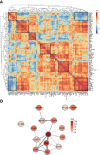Inflammation-related proteomics demonstrate landscape of fracture blister fluid in patients with acute compartment syndrome
- PMID: 37090725
- PMCID: PMC10115951
- DOI: 10.3389/fimmu.2023.1161479
Inflammation-related proteomics demonstrate landscape of fracture blister fluid in patients with acute compartment syndrome
Abstract
Background: Blisters are tense vesicles or bullae that arise on swollen skin and are found in a wide range of injuries. As a complication of fracture, fracture blisters are considered soft tissue injuries, which often lead to adverse effects such as prolonged preoperative waiting time and increased risk of surgical site infection. However, our previous study found that in patients with acute compartment syndrome, fracture blisters may be a form of compartment pressure release, but the specific mechanism has not been revealed. Here, we mapped out the proteomic landscape of fracture blister fluid for the first time and compared its expression profile to cupping and burn blisters.
Methods: First, fluid samples were collected from 15 patients with fracture blisters, 7 patients with cupping blisters, and 9 patients with burn blisters. Then, the expression levels of 92 inflammatory proteins were measured using the Olink Target 96 Inflammation panel. Protein profiles were compared across the three groups using Differential Protein Expression Analysis and Principal Component Analysis (PCA).
Results: Fracture blisters had significantly higher levels of 50 proteins in comparison to cupping and 26 proteins in comparison to burn blisters. Notably, PCA showed fracture blisters closely resembled the protein expression profile of burn blisters but were distinct from the protein expression profile of cupping blisters.
Conclusion: Our study provides the first characterization of fracture blister fluid using proteomics, which provides a valuable reference for further analysis of the difference between blisters caused by fractures and those caused by other pathogenic factors. This compendium of proteomic data provides valuable insights and a rich resource to better understand fracture blisters.
Keywords: acute compartment syndrome; blisters; cytokines; fractures; inflammation; proteomics.
Copyright © 2023 Long, Li, Wang, Ni, Guo, Dong, Yang, Guo, Wang and Hou.
Conflict of interest statement
The authors declare that the research was conducted in the absence of any commercial or financial relationships that could be construed as a potential conflict of interest.
Figures






References
-
- Guo J, Chen X, Lin Z, Jin L, Hou Z, Dong W, et al. . Tight junction disruption through activation of the PI3K/AKT pathways in the skin contributes to blister fluid formation after severe tibial plateau fracture. Front Bioengineering Biotechnol (2022) 10:946261. doi: 10.3389/fbioe.2022.946261 - DOI - PMC - PubMed
Publication types
MeSH terms
Substances
LinkOut - more resources
Full Text Sources
Medical
Research Materials

